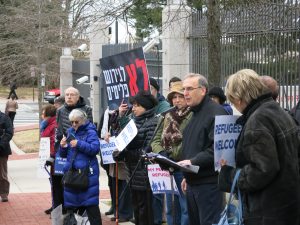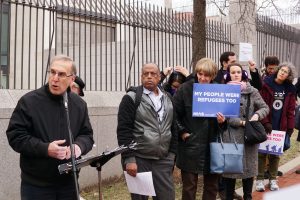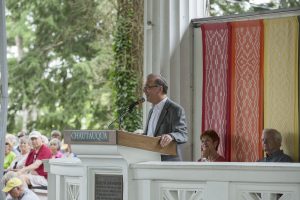It seems appropriate to begin a Kol Nidre sermon with a small confession. The standard conversation starter in American society is: “How are you doing?” How many times are you asked that question each year? Hundreds of times. Maybe more. There probably is an App that can count it, but please don’t tell me what it is. I’m really not that interested.
In any event, I, like most of you, respond to most, if not all of these inquiries by saying. “Fine”. I’m good”. Maybe even, “Great”. But here is my confession: I am really not OK. In fact, if you took the question far more seriously than is usually intended by the person greeting you, the only way you could say “I’m good” and be truthful about it is if you were Rip Van Winkle and you just woke up from a two-year nap.
Truth telling moment: How many of you share my sense that there is something terribly wrong happening in the world? Raise your hand. (pause) This is a good thing. If I had less than half the room raise their hands, the rest of this sermon is irrelevant and I’d call it a night.
The problem my friends is that core assumptions that many of us held about America and its institutions, about what is right and what is wrong, are simply no longer consensus positions. Everything seems to be up for grabs. And when our core assumptions are under assault every day, we begin to have doubts about our future, the future of our country and the future of the world. This is a far larger problem than who is in the White House, or who controls Congress, or who will sit on the Supreme Court. This is an existential crisis—something that challenges our faith in the future and our faith in humanity.
The Challenge
My guess is that each one of you could come up with a dozen examples of things taking place over the past year that have shaken you to your core. This is not the time or place to dwell on matters of public policy. There are other forums for that. But I do want to cite just a few examples as a way to illustrate the crisis that we are facing:
- Item: In the face of overwhelming scientific evidence about climate change, people who are climate change “deniers” occupy positions of significant power and influence in our country. We are the only country in the world that is not now a signatory to the Paris Climate Accord and the federal Environmental Protection Agency is reversing environmental protection regulations at an alarming pace.
- Item: In the face of Congressional inaction on immigration, the Trump Administration enacted the most mean-spirited and cynical policy of family separation at our southern border. Children as young as 3 years old were taken away from their families and moved hundreds of miles away, held mostly in detention centers. People fleeing for their lives from Central America were offered a deal: withdraw your request for asylum, which is guaranteed by international human rights law, return to your country regardless of the risks you might face and you can get your children back. Administration officials have bragged that this policy is “working” in that fewer people are coming across the border.
- Item: While mainstream media may not get every story right, the Founding Fathers of this country understood that a free press is the cornerstone of democracy, acting as a check on the excesses of government. We now have a President who, unhappy with the coverage of his policies, declares that the press is “the enemy of the people.” In a speech to the Veterans of Foreign Wars convention in Kansas City he stated: “What you are seeing and what you are hearing is not what is happening.” Mind-boggling!
Now I am well aware that some rabbis are refraining from wading into these waters for fear of offending some of their congregants. While I might sympathize with their dilemma, for me, this is not even a close call. I view these matters as fundamentally Jewish and moral issues and it is from that—rabbinic– perspective that I want to speak tonight. Let me start with the three items just cited.
On climate change: It is worth remembering that one of the first commandments in the Torah is addressed to Adam who is told by God that his responsibility towards the earth is “l’ovdah ul’shomrah”, to both work the land and to protect it. To allow the fossil fuel industry to spend hundreds of millions of dollars on what has been called “anti-science” so as to protect their profits, sets the stage for ecological catastrophe. Nor is that catastrophe a century away. Look at the news; people are literally drowning in ecological catastrophe as we speak. Our responsibility is to pass on to our children a world that is better than the one we inherited. We are failing in that objective, big time.
On immigration: We are hearing heart-wrenching stories from our southern border. Let us remember: we were those refugees only one generation ago. And we’ve seen this movie before. What starts out as linguistic defamation—Hitler called Jews “vermin” and a cancer on society; Mexicans were called murderers and rapists by then-candidate Trump—sets the stage for total de-humanization of the targeted population. Enough of the public is convinced that the supreme leader is protecting them from danger that they allow public officials to do whatever it takes to get the job done. The end, they would argue, justifies the means. Nothing can be further from the Torah’s teaching that we believe that every human being is made in the image of God; that every person, regardless of race, religion or place of origin, has infinite value.
On journalism and truth telling: Here too, history is instructive. Autocrats stay in power by controlling information. Nazi Germany proved that you could sell the public on the “big lie” if you said it often enough and you have it come from people in authority. Communist Russia allowed for no free press. All news came from the state organ which was called Pravda, the Russian word for “truth”. In Pirkei Avot, Ethics of our Ancestors, we have a Mishna that adorns the beams of our sanctuary at Adat Shalom: Al shlosha dvarim haolam kayam, “On three things is a society sustained…”. Al ha-din, al ha-emet, v’al ha-shalom, “…on the rule of law, on speaking truth and on pursuing peace.” So basic is the truth principle in Judaism that emet, the Hebrew word for truth, is one of the many names for God in the Bible—el Emet.
So how do we reconcile the gap between what we have been taught is good, and sacred and true and the direction that our country and the world seem to be going?
Two Responses
We need a strategy for staying sane in a world gone mad. Let’s consider two: Go private or resist.
1. Go Private. When the public square turns out to be too much to bear, many people take refuge in the private, personal sphere. People can choose to spend their time and psychic energy on family, friends, work, hobbies, sports, entertainment, etc. and shut themselves off from the craziness going on in the world. On the surface, it all sounds well and good. But it is also problematic.
Judaism teaches in Deut ch. 22: lo tuchal lehitaleym, “you may not turn away”. It appears in the context of someone losing an object. You may not have played any part in a person losing an object. Yet still the Torah says, if someone is suffering a loss, you are not permitted to just walk on by. A Jew is not permitted to “opt out” from the troubles of the world. Judaism teaches us to engage pro-actively because we must care about the suffering of others. Period.
How much moreso if one’s entire society seems to be going in the wrong direction. If every person decides to go private, the consequences could be disastrous. Yale history professor Timothy Snyder wrote a short book soon after the election called On Tyranny that became a surprise bestseller. He urges Americans to heed the lessons of history. He writes: “The European history of the 20th century shows us that societies can break, democracies can fall, ethics can collapse and ordinary men can find themselves standing over death pits with guns in their hands.” Overstated? Maybe. Worth heeding? Without question.
2. Resist. I have to admit, this option appeals to me on many levels. It appeals to my activist impulse. It feels consistent with how I understand the teachings of Judaism. It allows me to channel my outrage and my anger in more constructive directions.
Several Jewish organizations have taken leadership in the resistance. Most prominently, Bend the Arc: The Jewish Partnership for Justice, the Religious Action Center for Reform Judaism, and Truah: The Rabbinic Call for Human Rights. Locally, Jews United for Justice, led so ably by our own Jacob Feinspan, has been doing amazing work as well. I have personally given money, signed onto campaigns and shown up for rallies with all of these groups and I have tremendous admiration for their leaders, most of whom are good friends of mine. I’ve also gotten involved with the Poor People’s Campaign led by the Rev. William Barber. If you have never heard Rev. Barber speak or heard about the Poor People’s Campaign that he leads, I urge you to check him out on You Tube. An African American pastor from North Carolina, William Barber is a voice every bit as powerful and prophetic as was Dr. Martin Luther King.
But I also have concerns about the strategy of resistance. First, not unlike the challenge facing the press, the list of issues that require focused organizing is overwhelming: tax policy; public education; racism; voter suppression; mass incarceration; LGBTQ rights; women at risk; poverty; environmental protection; DACA; militarization of our police departments. That is only a partial list. Each issue deserves laser-like attention and there is not enough money or people power to go around. A citizen of conscience can quickly become overwhelmed.
Second, I find it hard to strike the balance between having a sense of urgency—which seems highly appropriate given this moment in history– and the emotions of anger and even hate that get stirred up in me as I engage on any of these issues. Part of this is built into the fabric of electoral politics. Democrats are counting on the electorate to get angry enough about the direction of the country that they will turn out in big numbers in the coming elections. The sad lesson that we learned in the 2016 elections is that anger and hate are far more effective at getting voters out than messages of hope and promise. It is a sad commentary on the human condition and it explains why politics has become so negative and nasty.
Upon reflection, though, I am troubled by a resistance strategy that results in one side demonizing the other side. It strikes me as a Catch 22 that is inconsistent with Judaism’s highest aspirations.
A Better Way
So where does that leave us? I promised you a way to stay sane in a world gone mad. Back in July I was in a pretty dark funk. In the space of one week, the Trump Administration implemented its policy of separating children from their parents at the border; plans were announced to “celebrate” the one-year anniversary of the hate march in Charlottesville, this time to take place in Washington DC; and Antwon Rose, an unarmed black teen, was shot dead by a police officer in Pittsburgh. Going private seemed irresponsible. Resistance seemed futile.
We had plans with friends for dinner and a movie and I announced my strong desire to see the Mr. Rogers film, “Won’t you Be My Neighbor?” Our friends indulged me.
Now I have to admit, in our years of raising three children, we never turned on Mr. Rogers. Sesame Street was our show of choice. The brief glimpses of Mr. Rogers that I might have seen as we flipped channels struck me as kind of square, simple and—don’t laugh–childish. I now understand that I was not wise enough as a 30-something year old Dad to see that what Mr. Rogers had to offer might be precisely what the world needs—simple human kindness.
One scene in the movie illustrated the way that Mr. Rogers weighed in on an issue that has divided our nation for two centuries—racial discrimination. Police officer Clemons was a regular character on Mr. Rogers and he was Black. In one scene, Mr. Rogers is soaking his bare feet in a plastic kiddy pool. Officer Clemons walks into the scene and Mr. Rogers says, “Isn’t it hot today? Officer Clemons, why don’t you come sit beside me and put your feet in the pool?” Officer Clemons does just that. He takes off his shoes and socks, puts his feet in the pool, next to the feet of Mr. Rogers. The scene made me think of the throngs of angry white people jeering and threatening the life of James Meredith, as he broke the color barrier entering the University of Mississippi in 1962. Or even more horrific, two years earlier, when Ruby Bridges, a black child, age 6, walked into a previously, all-white elementary school in New Orleans. The photos of angry white people screaming and shaking their fists at a 6-year old girl, is a stain of shame on America. It struck me that the scene in the kiddy pool, with Officer Clemons was an entirely original and profound form of “resistance” to the legacy of white racism in America. It was resistance, Mr. Roger’s style.
At the end of the scene, Mr. Rogers lovingly dries the feet of Officer Clemons, a powerful Christian practice, started by Jesus, in which a person in a position of power shows humility by engaging in an act that might otherwise be done by a servant for his or her master. You may remember that soon after the election of Pope Francis, one of his first acts was to travel to a prison outside Rome where he washed the feet of 12 prisoners.
“Won’t you Be my Neighbor” is filled with similar scenes of simple human kindness. Watching it at a time when our country seems to be in a downward spiral of anger, hate and mean-spiritedness, left me crying like a baby.
Fred Rogers, an ordained Presbyterian minister, shared his favorite story when he gave the Commencement address at his alma mater, Dartmouth, in 2002. The story speaks volumes. I want to share it with you.
“Have you heard my favorite story that came from the Seattle Special Olympics? Well, for the 100-yard dash, there were nine contestants, all of them so-called physically or mentally disabled. All nine of them assembled at the starting line, and at the sound of the gun, they took off. But not long afterward, one little boy stumbled and fell, hurt his knee and began to cry. The other eight children heard him crying. They slowed down, turned around, and ran back to him. Every one of them ran back to him. One little girl with Down Syndrome bent down and kissed the boy, and said, “This will make it better.” The little boy got up, and he and the rest of the runners linked their arms together, and joyfully walked to the finish line. They all finished the race at the same time. And when they did, everyone in that stadium stood up, and clapped, and whistled, and cheered for a long, long time. People who were there are still telling this story with great delight. And do you know why? Because deep down, we know that what matters most in this life is more than winning for ourselves. What really matters is helping others win, too. Even if it means slowing down and changing our course.”
Conclusion
My friends. In the coming days, weeks, months, and, I dare say, years, there will be times when to stay sane you will have to go private, seeking the sanctuary of home, family and friends. There will be other times when you will mobilize yourself to be part of the resistance, choosing the issues that matter most to you and determining the best way to spend your time and resources to make a difference in our troubled world.
But, this evening, I want to urge you to re-double your efforts to practice chesed, random acts of simple human kindness, one to the other. Practice the Torah of Mr. Rogers. It happens to be a darn good definition of teshuva, repentance: “Deep down, we know that what matters most in this life is more than winning for ourselves…even if it means slowing down and changing our course.”
The only way for Jews to respond to a world gone mad is to rebuild the world we want to live in on a foundation of human kindness—chesed.
May it be true for all of us in the coming year. Shana tova.
This was a sermon delivered to Adat Shalom Reconstructionist Congregation, Bethesda, MD on Kol Nidrei, 2018.


